Background
Modern browsers do away with the classic status bar and instead draw a small tooltip at the bottom of their windows that displays the link target on hover/focus.
An example of this (undesirable, in my case) behavior is illustrated in the following screenshot:

Questions
- Is there a portable way to disable these tooltips?
- Am I missing any obvious drawbacks to doing this in my particular situation?
- Is my attempt (see below) a reasonable way of accomplishing this?
Reasoning
I am working on an intranet web application and would like to disable this behavior for some application-specific actions because quite frankly, https://server/# everywhere looks like an eye-sore and is obtrusive since in some instances my application draws its own status bar in that location.
My Attempt
I'm not a web-developer by trade, so my knowledge is still rather limited in this domain.
Anyway, here's my attempt with jQuery:
<!DOCTYPE html>
<html lang="en">
<head>
<meta charset="utf-8">
<title>Target Tooltip Test</title>
<style>
a, span.a {
color: #F00;
cursor: pointer;
text-decoration: none;
}
a:hover, span.a:hover {
color: #00F;
}
a:focus, span.a:focus {
color: #00F;
outline: 1px dotted;
}
</style>
<script src="http://code.jquery.com/jquery-1.7.2.min.js"></script>
<script>
$(document).ready(function() {
patch();
});
function patch() {
$('a').each(function() {
var $this = $(this).prop('tabindex', 0);
if($this.prop('href').indexOf('#') == -1 || $this.prop('rel').toLowerCase() == 'external') {
return;
}
var $span = $('<span class="a" tabindex="0"></span>');
$span.prop('data-href', $this.prop('href'));
$span.text($this.text());
$this.replaceWith($span);
});
$('a[rel="external"]').click(function() {
window.open($(this).prop('data-href'));
return false;
});
$('span.a').click(function() {
location.href = $(this).prop('data-href');
}).keypress(function(event) {
if(event.keyCode == 13) {
location.href = $(event.target).prop('data-href');
}
}).focus(function() {
window.status = ''; // IE9 fix.
});
}
</script>
</head>
<body>
<ol>
<li><a href="http://google.com" rel="external">External Link</a></li>
<li><a href="#foo">Action Foo</a></li>
<li><a href="#bar">Action Bar</a></li>
<li><a href="#baz">Action Baz</a></li>
<li><a href="mailto:support@example.org">Email Support</a></li>
</ol>
</body>
</html>
patch() replaces all links containing # (i.e., application-specific actions in my case) with a span element, makes all "external" links open in a new tab/window and doesn't seem to break custom protocol handling.